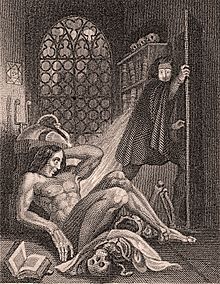
Back خيال قوطي Arabic গথিক কল্পকাহিনী Bengali/Bangla Gotično Czech ادبیات گوتیک Persian Fiksi Gotik ID 고딕물 Korean Fictio gothica Latin Gothic fiction SIMPLE Gotički roman Serbian Gotisk fiktion Swedish

Gothic fiction, sometimes called Gothic horror (primarily in the 20th century), is a loose literary aesthetic of fear and haunting. The name refers to Gothic architecture of the European Middle Ages, which was characteristic of the settings of early Gothic novels.
The first work to call itself Gothic was Horace Walpole's 1764 novel The Castle of Otranto, later subtitled "A Gothic Story". Subsequent 18th-century contributors included Clara Reeve, Ann Radcliffe, William Thomas Beckford, and Matthew Lewis. The Gothic influence continued into the early 19th century; works by the Romantic poets, like Samuel Taylor Coleridge and Lord Byron, and novelists such as Mary Shelley, Charles Maturin, Walter Scott and E. T. A. Hoffmann frequently drew upon gothic motifs in their works.
The early Victorian period continued the use of gothic aesthetic in novels by Charles Dickens and the Brontë sisters, as well as works by the American writers Edgar Allan Poe and Nathaniel Hawthorne. Later well-known works were Dracula by Bram Stoker, Richard Marsh's The Beetle and Robert Louis Stevenson's Strange Case of Dr Jekyll and Mr Hyde. Twentieth-century contributors include Daphne du Maurier, Stephen King, Shirley Jackson, Anne Rice, and Toni Morrison.